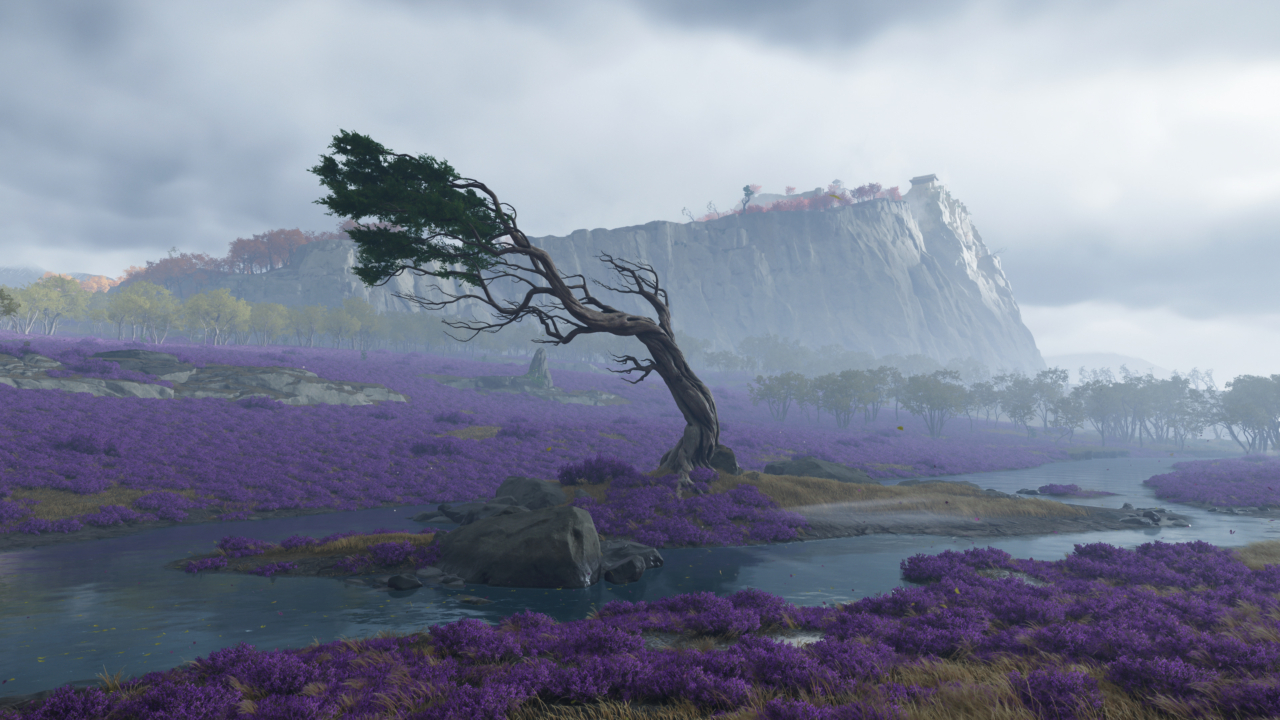The year that the game takes place, 1603, is a pivotal moment for these politics. This is when the Tokugawa Shogunate was formed by Tokugawa Ieyasu, putting an end to decades of civil war. Hokkaido was a rugged and sparsely populated home to Indigenous Ainu people that, in the coming years, experienced a gradual colonial takeover by southern forces. We bear witness to these changes being wrought on the landscape: newly erected wooden fortifications alongside masses of stubby, felled trees. In the western Ishikari Plain, the fire of warfare lights up the sky: a brighter, more intense orange than the autumnal vegetation. At another onsen, Atsu, reflecting on the changing demographics of Hokkaido, says, “I can see the south in its people.”
The game’s chief antagonist, Lord Saito, is hellbent on culling the wolves still living on the island, a means of him “taming” the region—extending fascistic power over ecology and society. One of these lupine creatures strikes up a bond with Atsu, frequently joining her in battle, sinking its teeth into the flesh of her—and its—foes. Connell sees the two characters as “deeply paralleled” in the sense that they are both “forces of nature,” he said, ripping across the land like one of the game’s turbulent weather fronts. Atsu herself is a distinctly modern hero: frequently denigrated by men for being a woman (criticisms she curtly bats away) while also possessing an innate sense of environmental justice. There is no denying the deep catharsis of cleaving her katana through the men colonizing this place and its people.
The history of video games is rife with game makers employing nature to artistic ends. Showcases for video game engines typically focus on the ways technicians and engineers can mimic environmental forces with ever-greater verisimilitude: light, physics, foliage, water, rain, rock. Critics of video games commonly blame them for young people’s rising apathy toward the outside world. But ecological phenomena are beamed into the home in ever-more wondrous configurations—and there is evidence to suggest this simulation can provide, if not equal psychological benefits, then something comparable.
Such hyperrealistic depictions of nature are, of course, used by corporations to sell services. Nearly every Ghost of Yōtei trailer and promotional image features the ginkgo tree, a famously resilient shrub with rich, lemon-yellow leaves. But Connell, Wang, and their colleagues do not invoke it shallowly. Ginkgo becomes the defining leitmotif for Atsu’s personal odyssey. “You can cut that thing down, set it on fire, whatever, and there’s a chance it’ll come back,” said Connell. The co-creative director likens Ghost of Yōtei’s use of nature to Hayao Miyazaki’s 1997 anime classic, Princess Mononoke, “almost like a support structure inside the film,” he said. Both movie and game prominently feature wolves, now extinct in Japan. These animals are, in essence, historical artifacts—and because of this, they carry in their being a wistful sadness, the sense of an age which has definitively passed.
The name, Ghost of Yōtei, is also telling. Atsu is seen by many in the game as an onryō, a vengeful folkloric spirit who haunts Hokkaido. But in this video game, the land itself is something of a specter, a reanimated version of a place and people which does not exist in nearly such abundance. In this way, Ghost of Yōtei lives up to its title: Here is a video game that doubles as an elegy.

